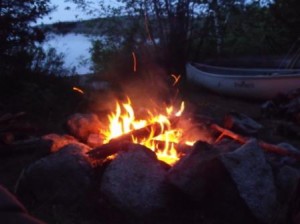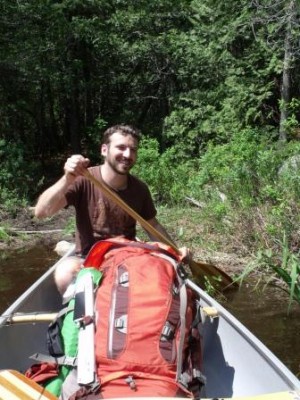 We all enjoy getting to explore the great outdoors in the summertime. With so many beautiful lakes and campgrounds around Manitoba, you really don’t have to go far to leave the day-to-day behind, have an adventure and experience the wonderment of being completely surrounded by nature (and that magical boreal forest)!
We all enjoy getting to explore the great outdoors in the summertime. With so many beautiful lakes and campgrounds around Manitoba, you really don’t have to go far to leave the day-to-day behind, have an adventure and experience the wonderment of being completely surrounded by nature (and that magical boreal forest)!
Many of us here at Green Action have been camping this summer, and it is exciting to hear where everyone has been visiting. Talking through trips and tips together brought up a lot of discussion around steps we should all be taking to ensure minimal impact when camping – so we thought we would share them with you! If you have any extra eco-conscious camping tips, please leave them below and I will add them to the post!
Guiding Points: Leave No Trace Principles
The leave no trace principles are overarching guidelines designed to help individuals make proper decisions to have minimum impacts when spending time in the outdoors. There are seven principles listed below. Visit the leave no trace website for more detail or keep reading to see a few specific examples.
1. Plan Ahead and Prepare
2. Travel and Camp on Durable Surfaces
3. Dispose of Waste Properly
4. Leave What You Find
5. Minimize Campfire Impacts
6. Respect Wildlife
7. Be Considerate of Other Visitors
Our Top Issue Picks
What to do about your number 2!
I thought my partner was joking when he handed me the book “How to Shit in the  Woods“. I laughed out loud, but when I opened up the book, I discovered that this is actually a serious matter!
Woods“. I laughed out loud, but when I opened up the book, I discovered that this is actually a serious matter!
If you are not disposing of your waste properly, you can pollute the water sources, spread disease, or…someone else can ‘find’ it (and they probably would not be too happy)! If you are following the proper steps, your waste actually decomposes faster and more efficiently!
Kathleen Meyer’s book gets into the specifics, but simply put, you need to make sure you choose a spot to do your business at least 200 feet away from any water, camp, or trails. Once you get there, you need to dig a hole 6-8 inches deep and make sure to cover it up (WELL) when you are finished!
Squeaky Cleaning
It is absolutely key that you use completely biodegradable soaps when camping.  But it goes even further than that, in fact, you should not ever get any soap in a watersource. All soap, even soaps that are biodegradable can increase nitrogen, and can cause harm to aquatic inhabitants.
But it goes even further than that, in fact, you should not ever get any soap in a watersource. All soap, even soaps that are biodegradable can increase nitrogen, and can cause harm to aquatic inhabitants.
When you are cleaning dishes or yourself while camping, make sure you are 200ft away from the water, camping area, and trails. Use as little biodegradable soap as possible. When you are finished, scatter the water in an area that gets plenty of sunlight. This will help to dilute the impacts and odors, and the sunlight will help the water to evaporate.
If you are camping in an area with a lot of wildlife, you will want to minimize the odors by dumping your water in a hole 6-8 inches deep, and an appropriate distance from water/camp/trails as mentioned above.
Proper Food Storage
It is also important to remember how to minimize our impact on the wildlife that we encounter. Access to human food can negatively impact wildlife in a variety of ways. So, to ensure that wildlife do not have access to your food (and that you don’t go hungry), follow these instructions from the Leave No Trace Centre for Ethics Community blog post, to store your food in a safe spot:
One method for properly storing food, trash and other smelly items is called a bear bag hang. Here are simple steps to successfully completing a single tree hang.
1. First make sure you have equipment you can use, which includes: durable Bags—nylon stuff sacks work well; 50 ft of rope; carabiners—this will help you clip your bags together and on to the rope.
2. Gather all of your smellable items to store in the bags. This includes food, trash, dirty dishes and cookware, deodorant, toothpaste and bug repellant.
3. Choose a tree that is 200+ ft. away from the cooking and sleeping areas of your campsite. Ideally, the cooking, sleeping and bear bag areas will form a triangle with 200ft. along each side.
4. Choose a tree with a sturdy branch at least 12 ft. off the ground, and a minimum of 6 ft. from the trunk of the tree or nearest branch.
5. Attach a rock to one end of the rope and throw over the 12ft. branch, making sure it is 6 ft or more from the trunk. (This may take a few tries. Remember, safety is important, so make sure to clear the area of people when throwing the rock).
6. A variety of knots can be used at the end of the rope to attach the bag(s). Then clip the bags together and to the knot using your carabineers. Hoist the bags into the air—again, 12 ft. up and 6 ft. out. You may need a friend or two to help with this part.
7. Tie the free end of the rope to the tree, making sure it is secure and will not become undone overnight.
There are many other things you can do to make sure you are leaving no trace when you spend time in the wilderness, so read up and travel prepared. Practicing leave no trace principles ensure that our natural environment continues to thrive, and that everyone can continue to enjoy these spaces for generations to come!
If you have any eco-conscious camping tips or tricks, please share them with us below!




Recent Comments